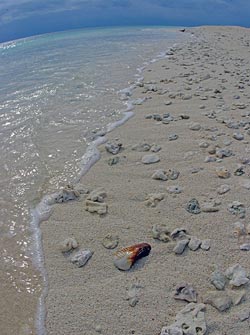
Physical Feature: Sand
You can tell a lot about the geology of a seaside area by its sand. Since Hawaiʻi does not have a continental source of quartz most of our sand is derived from ground coral, urchin spines, algae, and shells. In the main Hawaiian Islands volcanic material, such as basalt, and olivine also contribute to sand. The famous green sand beach near South Point on the Island of Hawaiʻi is green due to the olivine in the ground volcanic rock; other beaches are red from volcanic cinder. In the Northwestern Hawaiian Islands all the sand is biological in origin. The sand comes from the surrounding reef, and is ground up by wave action as well as by animals such as the parrotfish (uhu). Uhu scrape coral skeletons with their teeth to get algae. After the ground coral and algae pass through the parrotfish's intestines, and the algae is digested, it expels great clouds of sand. A large parrotfish can excrete nearly a ton of sand annually! Other major contributors to sand in Hawaiʻi are algae that grow calcium carbonate skeletons, such as calcareous algae and halimeda. Take a close look at the sand next time you are at the beach and see what kind of material it is derived from. Once you get past the idea that you are lying on parrotfish poop it's pretty neat what you can find.

